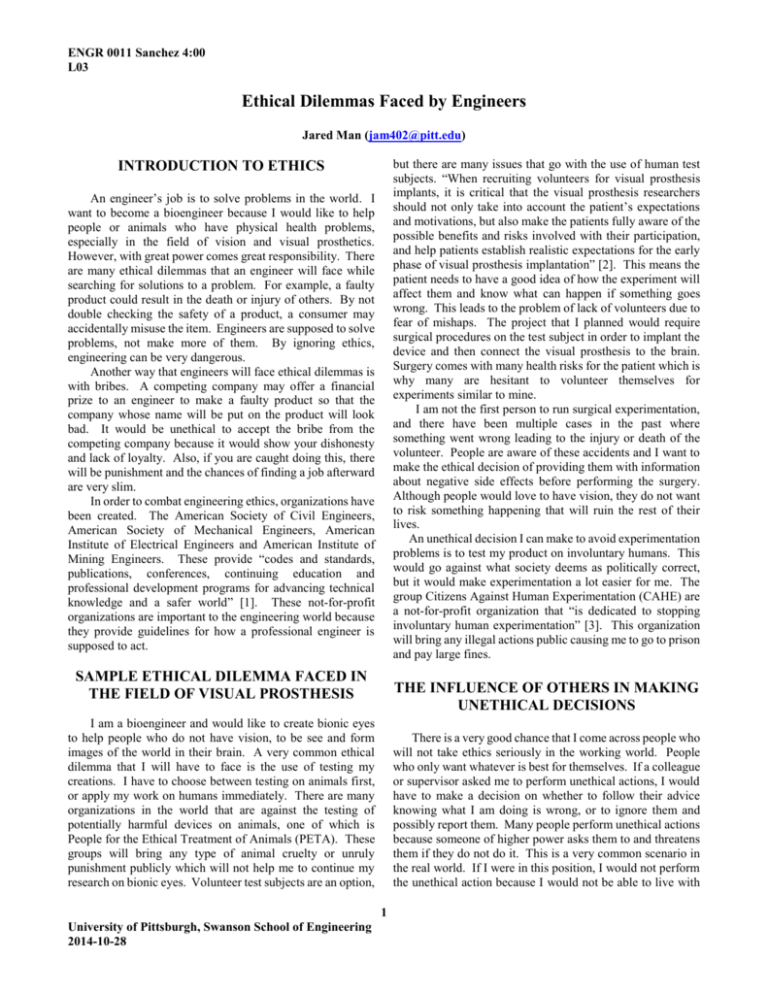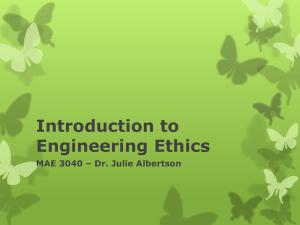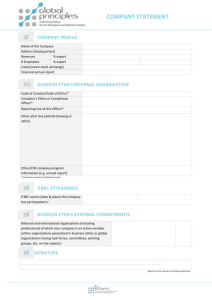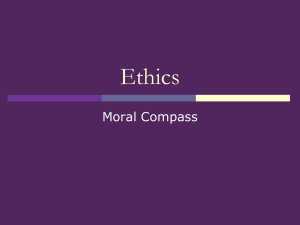Ethical Dilemmas Faced by Engineers
advertisement

ENGR 0011 Sanchez 4:00 L03 Ethical Dilemmas Faced by Engineers Jared Man (jam402@pitt.edu) but there are many issues that go with the use of human test subjects. “When recruiting volunteers for visual prosthesis implants, it is critical that the visual prosthesis researchers should not only take into account the patient’s expectations and motivations, but also make the patients fully aware of the possible benefits and risks involved with their participation, and help patients establish realistic expectations for the early phase of visual prosthesis implantation” [2]. This means the patient needs to have a good idea of how the experiment will affect them and know what can happen if something goes wrong. This leads to the problem of lack of volunteers due to fear of mishaps. The project that I planned would require surgical procedures on the test subject in order to implant the device and then connect the visual prosthesis to the brain. Surgery comes with many health risks for the patient which is why many are hesitant to volunteer themselves for experiments similar to mine. I am not the first person to run surgical experimentation, and there have been multiple cases in the past where something went wrong leading to the injury or death of the volunteer. People are aware of these accidents and I want to make the ethical decision of providing them with information about negative side effects before performing the surgery. Although people would love to have vision, they do not want to risk something happening that will ruin the rest of their lives. An unethical decision I can make to avoid experimentation problems is to test my product on involuntary humans. This would go against what society deems as politically correct, but it would make experimentation a lot easier for me. The group Citizens Against Human Experimentation (CAHE) are a not-for-profit organization that “is dedicated to stopping involuntary human experimentation” [3]. This organization will bring any illegal actions public causing me to go to prison and pay large fines. INTRODUCTION TO ETHICS An engineer’s job is to solve problems in the world. I want to become a bioengineer because I would like to help people or animals who have physical health problems, especially in the field of vision and visual prosthetics. However, with great power comes great responsibility. There are many ethical dilemmas that an engineer will face while searching for solutions to a problem. For example, a faulty product could result in the death or injury of others. By not double checking the safety of a product, a consumer may accidentally misuse the item. Engineers are supposed to solve problems, not make more of them. By ignoring ethics, engineering can be very dangerous. Another way that engineers will face ethical dilemmas is with bribes. A competing company may offer a financial prize to an engineer to make a faulty product so that the company whose name will be put on the product will look bad. It would be unethical to accept the bribe from the competing company because it would show your dishonesty and lack of loyalty. Also, if you are caught doing this, there will be punishment and the chances of finding a job afterward are very slim. In order to combat engineering ethics, organizations have been created. The American Society of Civil Engineers, American Society of Mechanical Engineers, American Institute of Electrical Engineers and American Institute of Mining Engineers. These provide “codes and standards, publications, conferences, continuing education and professional development programs for advancing technical knowledge and a safer world” [1]. These not-for-profit organizations are important to the engineering world because they provide guidelines for how a professional engineer is supposed to act. SAMPLE ETHICAL DILEMMA FACED IN THE FIELD OF VISUAL PROSTHESIS THE INFLUENCE OF OTHERS IN MAKING UNETHICAL DECISIONS I am a bioengineer and would like to create bionic eyes to help people who do not have vision, to be see and form images of the world in their brain. A very common ethical dilemma that I will have to face is the use of testing my creations. I have to choose between testing on animals first, or apply my work on humans immediately. There are many organizations in the world that are against the testing of potentially harmful devices on animals, one of which is People for the Ethical Treatment of Animals (PETA). These groups will bring any type of animal cruelty or unruly punishment publicly which will not help me to continue my research on bionic eyes. Volunteer test subjects are an option, There is a very good chance that I come across people who will not take ethics seriously in the working world. People who only want whatever is best for themselves. If a colleague or supervisor asked me to perform unethical actions, I would have to make a decision on whether to follow their advice knowing what I am doing is wrong, or to ignore them and possibly report them. Many people perform unethical actions because someone of higher power asks them to and threatens them if they do not do it. This is a very common scenario in the real world. If I were in this position, I would not perform the unethical action because I would not be able to live with 1 University of Pittsburgh, Swanson School of Engineering 2014-10-28 Jared Man the guild knowing what I did was wrong. Instead, I can report my supervisor to one of the many organizations which promote whistle blowing. Whistle blowing is “when a worker reports suspected wrongdoing at work. Officially this is called ‘making a disclosure in the public interest” [4]. There are laws in America which protect whistleblowers from the company retaliating. A worker can report a company or supervisor if they deem an action or order to be unhealthy or if it goes against their contract. The National Whistleblowers Center is a non-profit organization which “protects employees’ lawful disclosure of waste, fraud, and abuse” [5]. People who plan on bringing unethical actions of a company to the public can go to the National Whistleblowers Center to seek help and feel secure while talking about their experiences. If a “shortcut” that would get my product to market sooner, or would get my research and results noticed or published sooner has occurred to me, but could cause potential problems, I would not take this shortcut. Visual prosthesis surgery is a very dangerous procedure and I would not take any shortcuts when dealing with the safety of others. I believe that a human life is more important than any kind of financial profit and would rather make no money instead of hurting someone. If the shortcut would not be harmful to any kind of organism, I would consider using it because it would help speed up the process of getting my inventions published or save me a lot of money. CASE STUDIES RELATED TO BIOENGINEERNIG CASE 19 – THE ANIMAL LAB If I were scheduled to try my newly prototyped device in the local animal laboratory and know the animal will be shared with another team who will use the animal first for their purpose before I can use it for my project, then I notice that the animal seems to be “light” on anesthesia and makes strange noises during skin incision, I would stop and make sure that the animal is not suffering. I would not completely stop the procedure, but I will delay it in order to get more outside help and make sure the animal is not in pain. I would not anger the lab person by insisting he do things differently, but I would politely ask him to reconsider and explain my feelings of discomfort. If he gets mad and feels that I am insulting him, I will tell him I just want to make sure the animal is not being harmed. If he is positive the animal in not feeling any pain, I will continue the procedure normally. I can possibly call a veterinarian or the lab person’s supervisor who can hopefully support the lab person’s claim. This incident would be my problem if the lab person is correct and the animal is not feeling pain, but it would be the laboratory’s problem if he is wrong and I find out the animal is hurting. To avoid a situation similar to this in the future, I can have qualified helpers come in and make sure the right amount of anesthesia is administered. [7] ISSUES INVOLVING BIOENGINEERING AND PROSTHETIC LIMBS CASE 16 – A BRIGHT TEAM MEMBER Giving a person prosthetic limbs has been a very ethically challenging debate for many years. It is argued that by giving a person prosthetic limbs makes them a cyborg. The question, “Are they really fully human anymore?” arises and has been discussed thoroughly. Some believe that it is unethical to implant unnatural, manmade devices in or on the human body because it is mutilating the person. In the Jewish religion, it is forbidden to get tattoos or piercings because “this would seem to be mutilation of the body, regarded as nivulhameit, disgrace to the dead” [6]. Some argue that this body modification is for health reasons and should not be reprimanded in the Orthodox Jewish community. Jews who follow the Torah more strictly believe that this body modification should deny them the right to perform in synagogue rituals and be buried in a Jewish cemetery. Another problem that bioengineers face with prosthetic limbs is imperfection. The technology is still evolving and has many flaws which need to be fixed, yet people still receive prosthetic limbs. Is it right to give a child a prosthetic limb, or should they be allowed to grow up and learn how to live naturally without the artificial technology? The response to this question all depends on the answerer’s morals, ethics, and personal views or experiences. If I had an outstanding team member who always had great ideas and made me and another team member frustrated and devalued, I will tell my fellow frustrated team member that everything will be alright. Just because we do not come up with the greatest ideas does not mean we are not contributing members of the team. There is nothing we can do about the extremely bright team member because she is not doing anything wrong. She is actually making our team look better and that is all that matters; that the team succeeds in the end. If this happens, then we are doing our jobs correctly and there is nothing to worry about. Together, we can think of other roles we can play on the team, such as a leader, or mediator or arguments. We can be crucial parts of the team without being the most creative. I think it would be a good idea to discuss the issue with other team members. I would have Ms. Bright in attendance, telling her she is doing a good job and to keep it up. The best for me is to make sure the team does not fall apart because one person is rising above the rest. It is best if the team can assign roles for each member to make sure everything runs smoothly. Ms. Bright would be happy to hear that she is doing a good job and everyone else will be happy that they are contributing to the team in a positive way. [8] 2 University of Pittsburgh, Swanson School of Engineering 2014-10-28 Jared Man CASE 10 – THIRD WORLD CONSIDERATIONS This code of ethics is similar to the NSPE code of ethics, but the BMES has guidelines regarding patients and health care. For example, Bioengineers should “regard responsibility toward and rights of patients, including those of confidentiality and privacy, as their primary concern” [11]. If I were developing a tool used in hip replacement and I had to choose between two materials, A and B, where A is less expensive, but B will not weaken when exposed to the heat and pressure of autoclave sterilization, therefore having the ability to be reused, I would choose material B. I believe that the safety of humans is more important than money. I am not selfish enough to make others suffer for my own benefit. Especially knowing that doctors will reuse the device no matter what, I would want them to use a safer material. I do not believe that it matters whether doctors will reuse the device in some countries. The price would depend on what he country is able to afford. It would be based on the current status of their economy and how much money they have to spend on my devices. Third world countries who struggle to afford proper medical equipment would be offered the device at a cheaper price. On the other hand, countries which have better healthcare and the money to afford my device may be sold the device for a little bit more money. [9] CONCLUSION TO ETHICAL DILEMMAS FACED BY ENGINEERS In conclusion, ethics are a vital part to the engineering world. It is important that engineers know what is ethically correct and incorrect because we have the power to change the future and our products can be used by millions of people daily. I will always put safety above money because I feel that a human life is the most valuable thing in the world. As an engineer, I want to solve problems instead of creating more and by following a code of ethics, I can do that. Engineers are going to have to make tough decisions multiple times throughout their career and it is better if they choose the ethically right choice. ENGINEERING CODES OF ETHICS REFERENCES NATIONAL SOCIETY OF PROFESSIONAL ENGINEERS (NSPE) The National Society of Professional Engineers (NSPE) provides a general Code of Ethics for engineers of every type. The very first thing on the NSPE Code of Ethics is “Hold paramount safety, health, and welfare of the public” [10]. I find this very important because I believe that safety should come first. The job of an engineer is to solve problems of the world and find ways to improve life. By not putting safety first, you would be doing the exact opposite of what an engineers should do. You would only be causing more problems if your device or creation ends up hurting one or more people. I find that a lot of the codes and guidelines are up to the judgment of the engineer. This can be scary because one person may deem something safe, while another engineer says it is dangerous and will cause injury. It is hard to predict what will happen because there are too many unknown variables to account for. Overall, the NSPE provide a good set of broad guidelines that are not specific to one kind of engineering but covers a lot of crucial areas. BIOMEDICAL ENGINEERING SOCIETY (BMES) The Biomedical Engineering Society (BMES) created a Code of Ethics which was last updated in February of 2004. This code of ethics a lot shorter than the code of ethics created by NSPE, most likely because it is much more specific and aimed to guide a certain group of engineers and not all of them in general. The first thing on the BMES Code of Ethics is: Engineers shall “Use their knowledge, skills, and abilities to enhance the safety, health, and welfare of the public” [11]. 3 University of Pittsburgh, Swanson School of Engineering 2014-10-28 [1] “Mission, Vision, and Strategic Priorities.” (2014). ASME. (online article). https://www.asme.org/about-asme/who-we-are/. [2] Y. Xia, Q. Ren (2012). “Ethical Considerations for Volunteer Recruitment of Visual Prosthesis Trials.” Spring Science + Media. (online article). http://download.springer.com/static/pdf/851/art%25 3A10.1007%252Fs11948-012-93756.pdf?auth66=1414392149_08c9e2efaca0121211d2 c7f9fe71d1bf&ext=.pdf. [3] “Citizens Against Human Experimentation.” (2004). CAHE.org (online article). http://web.archive.org/web/20010202155300/http:/ www.cahe.org/. [4] “Whistleblowing.” (2014). Gov.uk. (online article). https://www.gov.uk/whistleblowing/overview. [5] “About Us.” (2007). National Whistleblowers Center. (online article). http://www.whistleblowers.org/index.php?option=c om_content&task=view&id=13&Itemid=42. [6] R. Wolfson (2014). “Death and Special Issues of the Body.” MyJewishLearning. (online article). http://www.myjewishlearning.com/life/Life_Events /Death_and_Mourning/Contemporary_Issues/The_ Body.shtml. [7] “Case 19-The Animal Lab.” (2014). Stanford Ethics Case Studies in Biodesign. (online article). http://biodesign.stanford.edu/bdn/ethicscases/18ani mallab.jsp. [8] “Case 16-A Bright Team Member.” (2014). Stanford Ethics Case Studies in Biodesign. (online Jared Man article). http://biodesign.stanford.edu/bdn/ethicscases/16bri ghtteammember.jsp. [9] “Case 10-Third World Considerations.” (2014). Stanford Ethics Case Studies in Biodesign. (online article). http://biodesign.stanford.edu/bdn/ethicscases/10thir dworld.jsp. [10] “NSPE Code of Ethics for Engineers.” (2014). NSPE.org. (online article). http://www.nspe.org/resources/ethics/code-ethics. [11] “Biomedical Engineering Society Code of Ethics.” (2004). BMES.org. (online article). http://bmes.org/files/2004%20Approved%20%20C ode%20of%20Ethics(2).pdf. ACKNOWLEDGMENTS I would like to thank my parents who I spoke to about my paper. My mother, who was an engineer, gave me good advice regarding the way an engineer should act and how to deal with ethical dilemmas. Additionally, I would like to thank the kind person at the writing center. Sadly, I do not know the name of this person, but she was able to give me pointers about the organization of my paper and I greatly appreciate her help. 4 University of Pittsburgh, Swanson School of Engineering 2014-10-28








